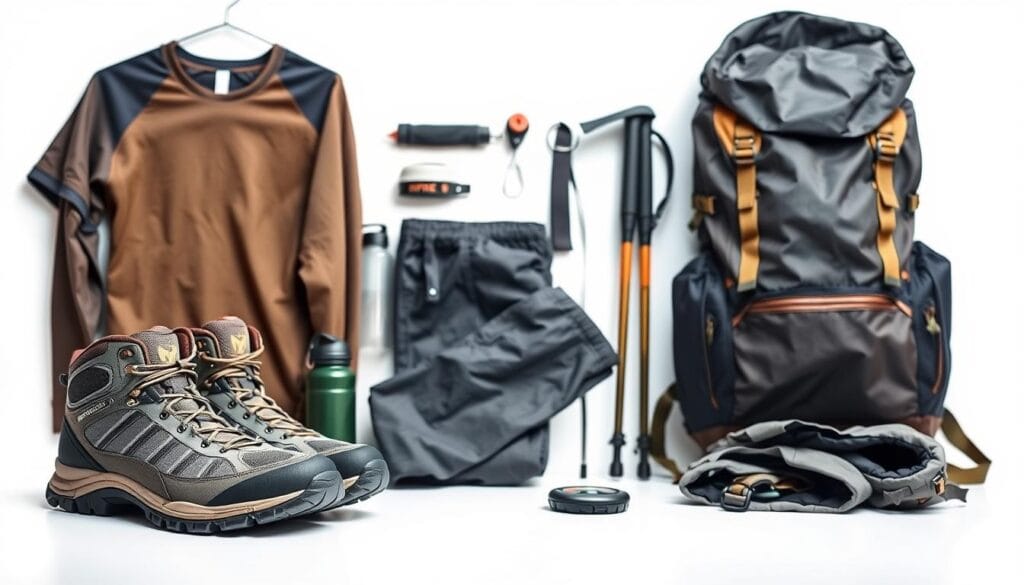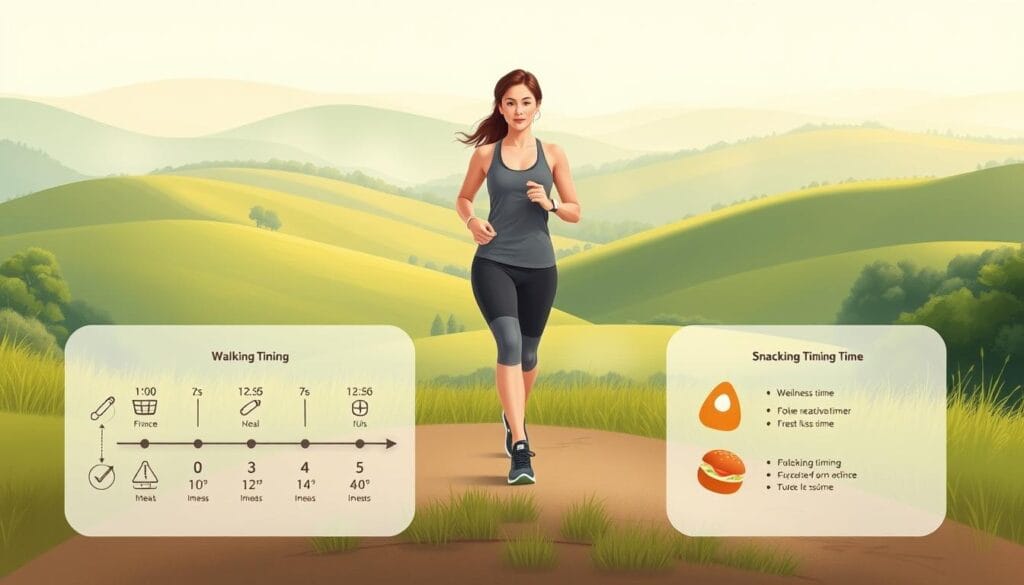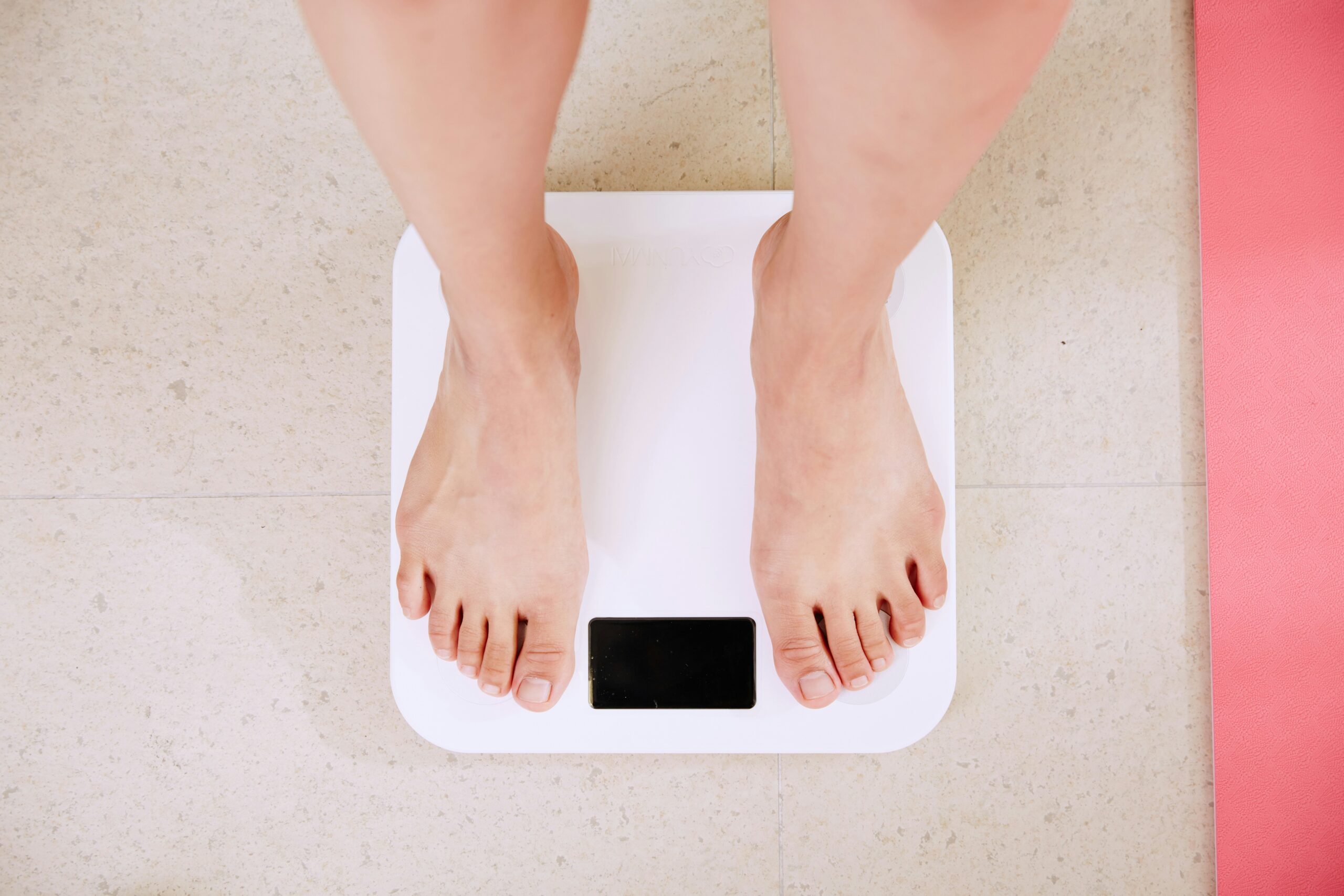Top 5 Weight Loss Myths , Debunked Weight loss is a topic that is often…
As an Amazon Associate I earn from qualifying purchases.
Walking for Weight Loss: How Many Steps Needed

How Many Steps Do You Really Need?
Looking for a simple way to stay active? Moving more throughout the day can make a big difference. One of the easiest methods involves putting one foot in front of the other—no gym membership required.
Many people wonder if this basic activity helps. The truth? It burns 100-140 calories per mile. That adds up quickly when done consistently.
The famous 10,000-step goal started as a marketing campaign in 1964. While it’s a good target, the right number varies by person. What matters most is finding a routine you can stick with long-term.
Health experts recommend at least 150 minutes of moderate movement weekly. This gentle approach often works better than intense workouts for lasting results. Small changes create big impacts over time.
Key Takeaways
- This activity burns 100-140 calories per mile
- The 10,000-step concept originated from a 1964 pedometer campaign
- WHO recommends 150 minutes of moderate movement weekly
- Consistency matters more than perfect numbers
- Gentle routines often yield better long-term results
Why Walking Is Your Secret Weight Loss Weapon
Not all workouts require breaking a sweat. A brisk 30-minute stroll torches 150 calories—equivalent to a small latte. Research shows even slower paces lead to results, making it a versatile fitness tool.
The Science Behind Calorie Burn
MET (Metabolic Equivalent Task) values measure activity intensity. A 3.5 mph walk scores 4 METs, while running hits 8 METs. But consistency trumps intensity: a year-long study found participants lost 4.5 lbs simply by moving daily.
Postmenopausal women saw weight loss at all speeds—proving duration matters more than pace.”
Walking vs. Other Cardio Exercises
Unlike high-impact exercise, it’s gentle on joints. This means fewer injuries and more sustainable habits. Here’s how it stacks up:
| Activity | Calories/30 Min | Impact Level |
|---|---|---|
| Brisk Walk | 150 | Low |
| Cycling | 240 | Moderate |
| Swimming | 200 | Low |
Pro tip: NEAT (Non-Exercise Activity Thermogenesis) boosts daily calories burned. Taking calls on the move or pacing during TV ads adds up.
Doubting its power? A 45-minute daily routine meets WHO guidelines—no gym required. Your heart rate stays steady, making it ideal for long-term walking help.
Unexpected Health Benefits Beyond Weight Loss
What if your daily stroll could sharpen your mind and strengthen your heart? While calorie burn grabs headlines, consistent movement offers rewards that outlast any number on the scale.
Your Heart’s Best Friend
A Journal of the American Heart Association study found that 7,000+ daily steps slash cardiovascular disease risk by 23%. Even 10-minute bursts improve circulation, lowering blood pressure over time.
“Participants with consistent routines showed healthier arteries than sedentary peers—regardless of age.”
Brainpower on the Move
Physical activity spikes BDNF, a protein linked to creativity and mood. Harvard research ties 9,800 steps daily to a 40% lower risk of dementia. Morning sunlight exposure also naturally regulates sleep cycles.
Lessons from the Blue Zones
Sardinian shepherds average 9+ miles daily—a habit tied to their exceptional longevity. Studies suggest 7,000+ steps may add 3 years to life expectancy. Social walks amplify benefits, combining connection with movement.
- Post-meal strolls: Stabilize blood sugar within 15 minutes
- Bone density: Preserves strength in aging adults
- Stress relief: Cortisol drops 26% after 20 minutes outdoors
Pro tip: Pair movement with podcasts or friends to boost mental health and consistency. The body thrives on rhythm—not just exertion.
Walking for Weight Loss: How Many Steps to Lose Weight?
Have you ever questioned whether the famous 10,000-step goal is backed by science? This benchmark began as a 1960s pedometer marketing campaign. While it’s a solid target, your ideal count depends on your current activity level and goals.
Debunking the 10,000-Step Myth
A Japanese clock company coined the 10k concept to sell step counters. Research shows that sedentary adults can benefit from taking just 6,000 steps per day. Consistency—not perfection—drives results.
Step Targets Based on Your Routine
Tailor your goal using these categories:
- Sedentary (<5,000 steps): Aim for 6,000–7,500 to start
- Low-active (5,000–7,500): Boost by 2,000–3,000 daily
- Active (10,000+): Focus on intensity or duration
*Pro tip*: Add a 30-minute walk to gain 3,000–4,000 extra steps day.
Calculating Your Calorie Burn
Every 3,000 steps burn ~150 calories. A 185-pound woman torches 100 calories/mile. Here’s the math for losing weight goals:
“A 500-calorie daily deficit (8,000 steps) could lead to 1lb/week loss.”
Try step banking: Walk extra on free days to offset busy ones. Gradually increase targets—your body adapts best to progressive challenges.
The Truth About Walking Speed and Fat Burn
Does moving faster really mean burning more fat? While intensity matters, the relationship isn’t linear. Your body uses energy differently at various paces—and understanding this can maximize results.
Moderate vs. Vigorous Intensity Guidelines
A moderate pace (3-4 mph) keeps the conversation comfortable. This burns fat efficiently without overstressing joints. At vigorous speed (4.5+ mph), breathing deepens noticeably.
A Journal of Sports Sciences study found that 3-minute intervals at a vigorous pace reduced belly fat 20% more than steady walks. The afterburn effect (EPOC) boosts calories burned post-activity.
Heart Rate Zones for Optimal Fat Burning
The so-called “fat-burning zone” (60-70% max heart rate) isn’t the whole story. While it uses fat for fuel, higher intensities burn more total energy. Find your zones:
| Age | Fat-Burning Zone | Vigorous Zone |
|---|---|---|
| 30 | 114-133 bpm | 142+ bpm |
| 50 | 102-119 bpm | 127+ bpm |
12-week interval walkers lost 2 inches from waistlines without diet changes—proving speed variations trigger metabolic shifts.”
Safety tip: Increase pace gradually. Use songs with 120-140 BPM as audio cues to maintain rhythm. Outdoor hills mimic 3-5% treadmill inclines for added intensity.
Rate your effort on this scale:
- 3/10: Stroll
- 5/10: Brisk but sustainable
- 7/10: Challenging conversation
Remember: The best fitness routine balances different intensities. Mix steady walks with 2-3 weekly interval training sessions for comprehensive benefits.
4 Ways to Transform Your Walk Into a Workout
Small changes in technique can dramatically boost results. These expert-approved methods turn everyday movement into a calorie-torching routine without extra time commitment.
Interval Walking Techniques
The 30:30 method alternates bursts of speed with recovery. Push for 30 seconds at a challenging pace, then ease back for 30 seconds. This training approach burns 20% more calories than steady-paced walks.
“Interval walkers saw 3x greater fat loss compared to continuous pace groups after 12 weeks.”
Incorporating Inclines and Terrain Changes
A 10% incline doubles calorie expenditure versus flat ground. Seek out hills or use treadmill settings. Stair climbing provides a 50% metabolic boost—perfect for short, intense sessions.
- Find a 6% grade hill for repeats
- Trail walking engages core muscles for balance
- Sand or gravel surfaces increase intensity
Adding Resistance With Weighted Vests
Start with 5% of body weight to avoid strain. Properly fitted vests should allow full arm movement. This low-impact method burns 50% more calories than bodyweight movement.
Posture Adjustments for Muscle Engagement
Proper form activates more muscle groups:
- Keep chin parallel to the ground
- Roll shoulders back and down
- Engage core throughout the movement
- Power walk with 90-degree arm bends
Pro tip: Finish with dynamic stretches like lunges or calf raises. These movements enhance flexibility and recovery after challenging sessions.
Step Counting Methods That Work
Tracking your movement doesn’t require expensive gadgets. The right tools help you stay consistent with your activity goals while providing accurate feedback. Whether you prefer tech or manual methods, several reliable options exist.
Smartphone Apps vs. Dedicated Trackers
Phone sensors typically underestimate steps by 15% compared to waist-worn devices. Wrist trackers like Fitbit and Apple Watch offer middle-ground accuracy. Placement matters—hip-mounted pedometers remain the gold standard.
| Device Type | Accuracy Range | Best For |
|---|---|---|
| Smartphone | 85% | Casual users |
| Wrist Tracker | 90-95% | All-day wear |
| Waist Pedometer | 97%+ | Precision tracking |
Free apps like Pacer and Google Fit work well for basic 10,000-step goals. For advanced metrics, dedicated devices provide more detailed activity breakdowns.
Time-Based Step Estimation Formulas
No tracker? Use these simple conversions:
- 30 minutes ≈ 3,000 steps day
- Minutes walked × 100 = estimated steps
- 1 city block ≈ 200 steps
“Manual counting for 15 seconds × 4 gives accurate minute-by-minute step rates during focused walks.”
Try these workplace hacks to boost your count:
- Take printer breaks every 30 minutes
- Pace during phone calls
- Use standing desk intervals
Pro tip: Audit your weekly totals every Sunday. This way you can adjust goals based on patterns rather than daily fluctuations.
Beginner-Friendly Walking Workout Plan
Starting a new fitness journey can feel overwhelming, but a gradual approach makes it manageable. This 4-week routine balances challenge and recovery, adapting as your stamina improves. Follow these phases to build endurance safely.
Your Progressive 4-Week Schedule
Week 1: Three 15-minute sessions plus 5,000 daily steps. Focus on consistency over speed.
Week 2: Increase to four 20-minute walks and 6,000 steps. Add gentle arm swings to engage muscles.
Week 3: Introduce intervals—25 minutes with 1-minute brisk bursts, aiming for 7,000 steps.
Week 4: Tackle varied terrain for 30 minutes five days, targeting 8,000 steps. Try trails or park paths.
“A 5% weekly intensity boost prevents injury while improving cardiovascular capacity.”
Rest Days and Active Recovery
Schedule two rest days weekly. Stay mobile with yoga, swimming, or gardening—activities that aid recovery without strain.
- Hydration: Drink 8 oz water 30 minutes before each session
- Foot care: Moisturize feet nightly and rotate shoes to prevent blisters
- Motivation: Reward milestones with non-food treats like new socks
Tracking Progress
Use a simple worksheet to log daily steps, energy levels, and mood. Notice patterns—like better sleep on active days—to stay motivated.
Remember, results compound over time. Celebrate small wins, like completing all weekly sessions or choosing stairs over elevators.
15 Sneaky Ways to Increase Daily Steps
Small tweaks to daily habits can significantly increase activity levels. These clever ways help you move more without overhauling your schedule. Best part? They fit seamlessly into regular life.
Workplace Movement Hacks
Office work doesn’t mean being chained to your desk. Try these simple adjustments:
- Take the scenic route to the printer—add 50 steps on each trip
- Stand during phone calls and pace when possible
- Schedule walking meetings (burns 35% more calories than sitting)
Parking farther away adds 500+ steps daily. Use stairwells for quick breaks—each flight counts as 15 steps.
Social Walking Strategies
Turn social time into movement opportunities:
- Meet friends for “walk-and-talks” instead of coffee dates
- Join local walking groups or charity events
- Challenge family members to daily step competitions
“Dog owners average 2,000 more steps daily—vary routes to keep it interesting for both of you.”
Errand Optimization Techniques
Daily things become step boosters with these tricks:
- Walk grocery store perimeters before grabbing a cart
- Use airport waiting time for terminal walks
- Do kitchen laps while coffee brews or food cooks
Mall walking provides climate-controlled exercise. Follow store directories for maximum distance between stops.
Pro tip: Sync movement with entertainment. Walk during podcast chapters or TV commercials. These small changes create big results over time.
Essential Gear for Walkers (Beyond Shoes)
Comfort and safety extend far beyond footwear choices. The right equipment enhances performance while preventing injuries—key for consistent fitness progress.

Weather-Appropriate Clothing Layers
Merino wool regulates temperature in all conditions. This natural fiber wicks moisture while resisting odors—perfect for multi-day use.
Technical fabrics make a difference:
- UV-protective fabrics with UPF 50+ block harmful rays
- Seamless designs prevent chafing during long sessions
- Convertible sleeves/pants adapt to temperature changes
Hydration Solutions for Long Walks
The body needs 16oz of water hourly during activity. Hands-free systems beat bottles for convenience:
| Type | Capacity | Best For |
|---|---|---|
| Waist packs | 20oz | Urban routes |
| Back reservoirs | 2L | Trail adventures |
“Proper hydration prevents 70% of exercise-related headaches and fatigue.”
Don’t overlook these game-changers:
- Anti-blister socks with moisture-wicking channels
- Reflective vests for low-light safety
- Trekking poles reduce joint impact by 25%
- GPS watches track distance and elevation
Pro tip: Pack a mini emergency kit with these things:
- Bandages
- Energy gels
- Compact rain poncho
With this gear, you’ll stay prepared for all days and conditions. That’s the smart way to maintain consistency.
Walking for Weight Loss: Common Mistakes
Small mistakes can turn a healthy habit into a painful ordeal. While moving more helps lose weight, poor form or gear choices may slow your progress. Let’s fix these errors before they derail your results.
Overstriding and Its Hidden Risks
Taking overly long steps increases injury risk by 40%. Your ideal stride? Multiply height (in inches) by 0.415. For a 5’6” person, that’s roughly 27 inches.
Overstriding forces joints to absorb extra impact. Instead, land mid-foot with a slight knee bend. Swing arms naturally—elbows at 90 degrees—to maintain rhythm.
“Runners and walkers who shortened stride by 10% reduced knee stress by 34%.”
Hand Weights: Help or Hindrance?
Dumbbells might seem smart for intensity, but they reduce speed by 20%. They also strain shoulders and alter posture. Opt for a weighted vest instead—it distributes load evenly.
- Weighted vest: Adds resistance without compromising form
- Posture check: Keep chin level, shoulders relaxed
- Surface matters: Grass or trails are gentler than concrete
Morning walks boost metabolism, but evening sessions relieve stress. Listen to your body—consistency trumps timing.
Pro tip: Watch for overtraining signs like persistent soreness or fatigue. Rest days are part of smart training.
Tracking Progress Beyond the Scale
True progress extends far beyond what any bathroom scale can measure. While weight changes matter, other indicators often better reflect health improvements and fitness gains.
Why Measurements Matter More Than Weight
Waist circumference predicts cardiovascular risk better than BMI. A 1-inch reduction can lower disease risk by 5-10%. Track these areas every week for accurate progress:
- Chest: Measure at nipple level
- Waist: Narrowest point above hips
- Hips: Widest part of buttocks
“Participants who tracked measurements alongside weight maintained motivation 40% longer than scale-only trackers.”
Celebrating Every Victory
Non-scale wins keep motivation high. Notice these results:
| Milestone | Health Benefit |
|---|---|
| Resting heart rate ↓5 bpm | Improved cardiovascular efficiency |
| Walking pace ↑10% | 15% calorie burn increase |
| Sleep quality improvement | Better recovery and appetite control |
Try these tracking ways:
- Take monthly progress photos in consistent lighting
- Note energy levels in a mood journal
- Time how long you can sustain a brisk pace
Pro tip: Set performance-based goals like completing a 5K walk. These achievements often outlast temporary weight changes.
Nutrition Tips to Support Your Walking Routine
Fueling your body right can double the benefits of your movement routine. The right foods provide energy when you need it and help muscles recover afterward. Think of nutrition as your invisible training partner—always working behind the scenes.

Smart Pre-Activity Fueling
Time your snack about 30 minutes before starting. Aim for 100-200 calories with simple carbs and a touch of protein. This combo provides steady energy without digestive discomfort.
Top choices include:
- Banana with almond butter
- Greek yogurt with berries
- Whole grain toast with honey
Skip high-fiber or fatty things right before activity. They digest slowly and may cause discomfort. Hydration matters too—drink 8oz water 30 minutes prior.
Post-Walk Recovery Essentials
The 30-minute window after activity is prime recovery time. A 3:1 carb-to-protein ratio helps replenish energy stores and repair muscles.
“Walkers who refueled properly showed 23% less muscle soreness and better next-day performance.”
Try these recovery combos:
| Option | Carbs | Protein |
|---|---|---|
| Chocolate milk | 26g | 8g |
| Turkey wrap | 30g | 15g |
| Smoothie | 40g | 12g |
Hydration Timeline
Water needs change throughout your day:
- 2 hours before: 16-20oz
- During: 4-6oz every 15 minutes
- After: 16-24oz per pound lost
For longer sessions, add electrolytes. Coconut water or sports drinks help maintain balance. Avoid alcohol—it dehydrates and slows recovery.
Pro tip: Pack portable snacks like trail mix or energy bars. They’re perfect for busy fitness enthusiasts. Proper nutrition makes every step count with less impact on your body.
Motivation Tricks for Consistent Walking
Behavioral science offers powerful tools for exercise consistency. Research shows simple psychological techniques can increase adherence by 35-50%. The right strategies turn movement from a chore into an automatic routine.
Smart Temptation Bundling Methods
Pair your activity with something enjoyable to create positive associations. Save favorite podcasts or audiobooks exclusively for movement time. This “only while walking” rule builds powerful mental connections.
Try these effective combinations:
- Listen to thriller novels during evening strolls
- Watch cooking shows on treadmill tablets
- Schedule friend calls while pacing outdoors
“Participants using temptation bundling completed 29% more weekly sessions than control groups.”
Accountability Systems That Work
Social commitment doubles success rates according to workplace studies. Join virtual challenges where teams track collective miles toward charity goals. Apps like Stridekick turn progress into friendly competitions.
For family motivation:
- Create a shared step leaderboard
- Offer non-food rewards for milestones
- Plan weekend “destination walks” to parks
Weather-proof your routine with backup plans. Indoor mall routes or home dance sessions maintain momentum during storms. Remember—perfection isn’t required in life, just consistent effort.
Pro tip: Track streaks visually with calendar X’s. The longer the chain grows, the harder it becomes to break. Small wins build unstoppable momentum.
When to Consider Adding Other Exercises
Your fitness journey might be signaling it’s time to level up. While consistent movement delivers great results, the body thrives on variety. Research shows adding complementary activities can boost progress by 40%.
Signs You’re Ready for Cross-Training
Watch for these plateau indicators:
- Your usual route feels easier but results stall
- Resting heart rate stops improving
- You recover faster than before
VO2 max—your oxygen efficiency—typically plateaus after six months of the same routine. This is when mixing in new challenges helps.
“Walkers who added strength training twice weekly saw 30% fewer injuries and better endurance.”
Smart Exercise Pairings
These low-impact options complement your routine:
Strength Essentials
- Squats (builds walking power)
- Planks (improves posture)
- Rows (balances upper body)
Yoga enhances flexibility—try downward dog and warrior poses. Swimming offers joint-friendly cardio, while cycling builds leg endurance.
| Activity | Frequency | Benefit |
|---|---|---|
| Strength | 2x/week | Injury prevention |
| Yoga | 1x/week | Mobility |
| Swim | 1x/week | Full-body cardio |
Pro tip: Track heart rate variability (HRV). Drops below your baseline signal need recovery days. Listen to your body—it knows best.
Conclusion: Making Walking a Lifetime Habit
The secret to lifelong fitness isn’t intensity—it’s showing up daily. Studies show 66% maintain results with consistent routine, versus just 34% without. That’s the power of small, daily actions.
All ages benefit. Grandparents walking with grandkids build bonds while boosting health. Neighborhood groups turn steps day into social events. Even vacations can include scenic routes.
Adjust for seasons: indoor tracks in winter, shady paths in summer. The goal? Keep moving, year after year. That’s how temporary efforts become permanent change.
Ready to start? Lace up and take that first step today. Your future self will thank you.
FAQ
Is 10,000 steps necessary for fat loss?
Not necessarily. Research shows benefits start at 5,000-7,000 daily steps. Your ideal target depends on current fitness levels and goals.
How does walking compare to running for burning calories?
While running burns more calories per minute, brisk walking for longer durations can achieve similar fat-loss results with less joint impact.
Can walking help reduce belly fat specifically?
Yes, regular aerobic activity like brisk walking helps reduce visceral fat. Combine it with strength training for best results.
What’s better for weight loss – distance or steps?
Focus on step count first. Once you consistently hit 7,000+ steps, add distance goals to progressively challenge yourself.
How long until I see results from walking daily?
Most notice improved energy within 1-2 weeks. Visible changes typically appear after 4-6 weeks of consistent 8,000+ step days.
Should I walk before or after meals for best fat burning?
A 10-15 minute post-meal walk helps manage blood sugar. For maximum calorie burn, schedule longer sessions when you feel most energetic.
Do I need special shoes for weight loss walking?
Properly fitted sneakers with good arch support prevent injuries. Brands like Brooks or Asics offer excellent options for daily movement.
How can I make walking more challenging as I progress?
Try interval training (alternating speeds), hill routes, or adding light hand weights once you’ve mastered the proper form.
Can I lose weight by walking without diet changes?
While possible, combining increased activity with mindful eating accelerates results. Focus on protein and fiber to support your routine.
What’s the best way to track steps accurately?
Fitness trackers like Fitbit provide reliable data. Smartphone apps work too, but carry your phone consistently for precise counts.
Amazon and the Amazon logo are trademarks of Amazon.com, Inc or it's affiliates.
Related Posts
- Top 5 Weight Loss Myths, Debunked
- Top Best Fruits for Weight Loss
Top Best Fruits for Weight Loss Starting a journey to lose weight naturally can be…
- Stop Overeating for Weight Loss
Stop Overeating for Weight Loss In a world bombarded with tempting treats and indulgent delights,…








